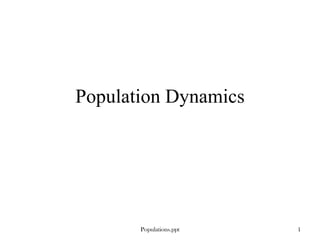Report
Share

Recommended
Introduction:
Life table:
Life table is a comprehensive method of describing mortality, survival and other vital events in a population.
It is composed of several sets of values showing how a group of infants who are under unchanging conditions would gradually die.
It provides concise measures of longevity of that population.
Separate tables are prepared for males and females after each decennium census.
It is also called as the “Biometer” of the population by William Farr.
Life table - construction and applications

Life table - construction and applicationsDr.K.RameshKumar, Assistant Professor,Vivekananda College,Tiruvedakam West, Madurai
More Related Content
What's hot
Introduction:
Life table:
Life table is a comprehensive method of describing mortality, survival and other vital events in a population.
It is composed of several sets of values showing how a group of infants who are under unchanging conditions would gradually die.
It provides concise measures of longevity of that population.
Separate tables are prepared for males and females after each decennium census.
It is also called as the “Biometer” of the population by William Farr.
Life table - construction and applications

Life table - construction and applicationsDr.K.RameshKumar, Assistant Professor,Vivekananda College,Tiruvedakam West, Madurai
What's hot (20)
Similar to Population dynamics
Similar to Population dynamics (20)
Exponential and Logistics Growth Curve - Environmental Science

Exponential and Logistics Growth Curve - Environmental Science
populationdynamicspresentation-130313073741-phpapp02.pdf

populationdynamicspresentation-130313073741-phpapp02.pdf
Ecology- organisms and populations class 12 notes in pfd

Ecology- organisms and populations class 12 notes in pfd
Effect of development on environment and population ecology

Effect of development on environment and population ecology
Population dynamics
- 14. Various species have various strategies for coping with a variable world. Populations.ppt
- 15. Two general types of Reproductive Strategies
- 18. Survivorship Curves Populations.ppt Type I survivorship curves are characterized by high survival in early and middle life, followed a rapid decline in survivorship in later life. Humans are one species that show this pattern of survivorship. Type II curves are an intermediate between Type I and III, where roughly constant mortality rate is experienced regardless of age. Some birds follow this pattern of survival. In Type III curves, the greatest mortality is experienced early on in life, with relatively low rates of death for those surviving this bottleneck. This type of curve is characteristic of species that produce a large number of offspring. One example of a species that follows this type of survivorship curve is the cockroach.
Editor's Notes
- A species is often defined as a group of organisms capable of interbreeding and producing fertile offspring
- Compare birth rate to death rate
- dN/dt = change in number of individuals per unit time
- dN/dt = change in number of individuals per unit time
- dN/dt = change in number of individuals per unit time
- Kaibob deer – in AZ, kill predators to protect deer, but then grew rapidly, until ate resources and began to starve.